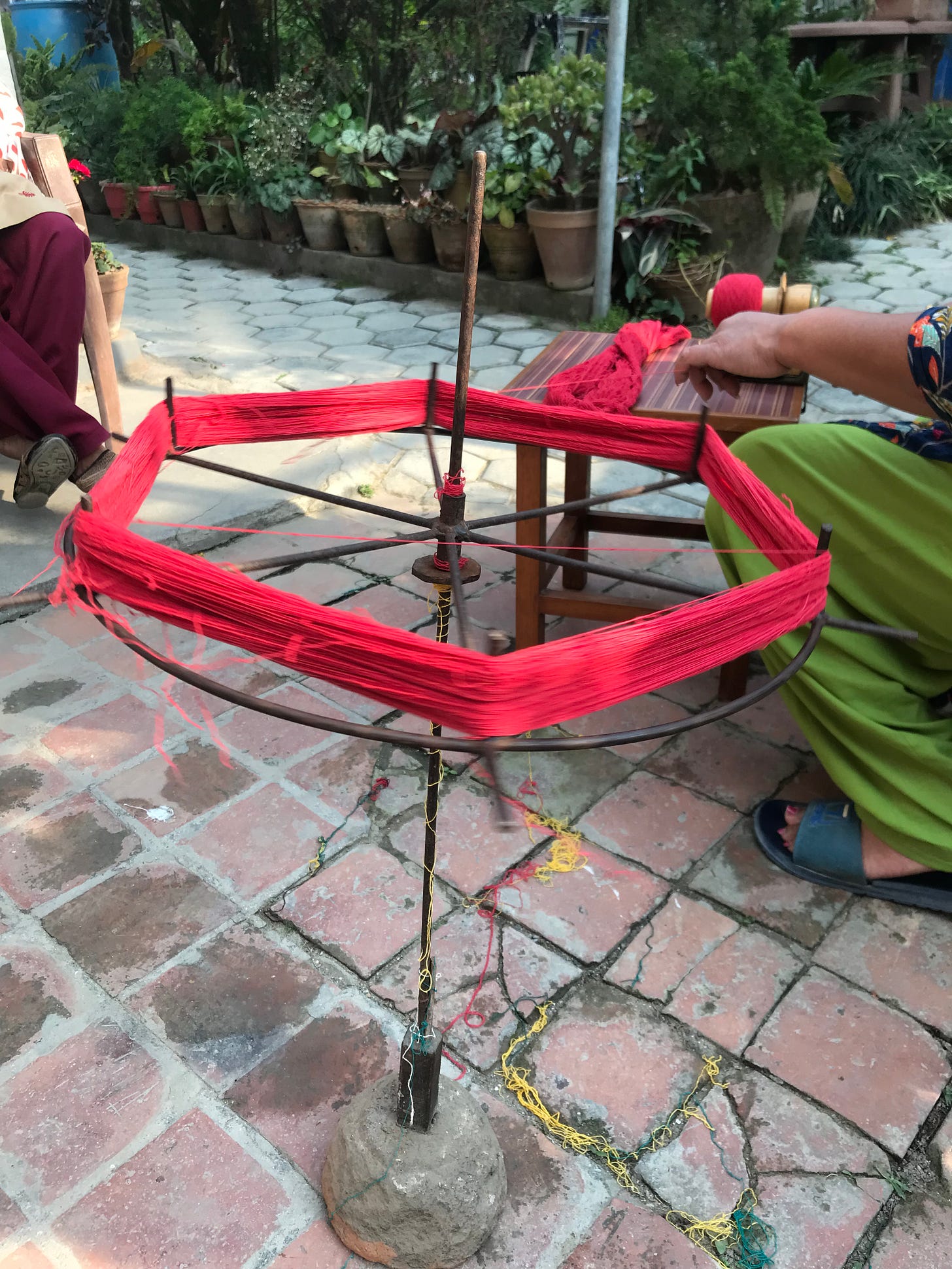Splish, splash, clickety-clack
Disclaimer: I don't know spinning wheel parts and terminology, so pardon my errors
Listen, I’m knocking on all the wood because I don’t wanna jinx it, but the water pipeline that, between development and construction, has been around for nearly as long as I’ve been here, seems to be… a success!?
Several times a week, the neighbourhood hums with motors—suction pumps pulling, filling everyone’s underground tanks. It would just trickle in at those appointed hours when it’s turned on, I suppose, but this way is much more efficient. So the better the pump and the bigger your sump, well, the more likely you are to have taps running when you need ‘em. Keeping the water running can sometimes feel like an actual job.
These new nighttime noises—timings seemed sporadic at first but are now mostly nocturnal—have joined the pattern of water noises I’ve come to known and expect since moving to this apartment, as the surrounding buildings each engage in their own water rituals.
During the day, there’s not the unity of pumps like there is tonight, when the water’s coming in. It’s sporadic then, individual pumps followed by, after a time, a splatter that becomes a gush as a tank overflows.
One house off to the right always catches me off guard, it sounds so close at hand; another, taller, building behind makes a long, sustained racket. And on the left, the house whose water tanks overflow from the higher, newer wing onto the tin-roof of the older floor below, a crazy metal pounding cacophony. It never lasts very long; probably because it is so loud and easy to hear.
Other houses seem to not notice theirs at times, which I can understand because I’ve learned that if I’m not at home to hear it literally thudding on my ceiling, the waterfall is inaudible to everyone on the lower floors of my building. Being up here, I seem to hear everyone else’s clearly too—after all, in most cases I’m above or on the same level as the tanks.
**
In this the man who runs the lunch-delivery service out of the basement and I, we’ve formed a sort of partnership at the two ends of our own little water supply chain. At night he’s the one who turns that suction pump on the evenings when the city water comes in, and mostly keeps the underground tank full. I keep an eye on when the two 3,000 liter tanks on our roof start getting low, and go down and turn another pump on (as I’ve mentioned before, there are four) to send it up. If the taps go dry, it’s whoever gets to it first, of course, but I try to avoid that since it always does a number on my water pressure for the next little while.
**
The buildings with the tin-roof-water-symphony house a significant number of people, and with smaller tanks they often need filling twice a day; the first, early-morning version, I’ve now learned to sleep through, mostly.
This afternoon it was overflowing again, only instead of it being immediately turned off and slowly dripping itself out, the xylophone getting slower and slower, it started up again after a few minutes, stopping abruptly after a while, only to have the process repeat again and again. I’ve noticed this a few times recently, but this felt like it went on for longer, and the very illogical-ness of it—no-one wastes water here after all—started to irritate me. Why would someone keep turning the pump back on when the roof-top tank was clearly full?
Peering over my bedroom balcony to the garden below, I saw, instead of gushing water on metal, my neighbour M— sitting next to her house and deftly using some sort of spinning contraption, the source of the clacking sound I kept hearing stopping and starting from below my window. Not, after all, water on metal.
Aside from feeling like an idiot, and a judgemental one at that, it’s interesting to me how I’ve come to interpret all similar sounding noises inn the neighbourhood as water related. I mean—they often are: as I type this water is gushing up from a tank somewhere a few meters from where I’m sitting at my desk. But this wasn’t, and I hadn’t even questioned it.
I was on my way out anyway and I hurried my departure so I could go down and have a look.
M— told me the cotton thread was for making wicks for the small clay-pot oil lamps used especially for worship and festivals. I’ve usually seen these made from white thread but hers was a vibrant red. She cleared a plastic chair and passed it over to me, all without moving from her seat, and got back to work.
Left hand turning the wheel, detangling and separating threads as she went, right turning a small contraption with a handle loaded with a large bobbin of thread, the sound of it making a noise not unlike a loud manual sewing machine. Or water hitting tin :)
This spinning wheel differed from others I’ve seen in that it was made of two separate components, unconnected except by a thread, that each looked as if they were from different eras: the old, hand made wheel, and more modern machine complete with handle for spinning the bobbin. I wonder if M— has put it together herself; I’ll have to ask her next time.
Sometimes the thread on the wheel—a rough looking skein where it must have originated sat nearby—snapped, or a tangle just couldn’t be resolved so she’d snap it herself, then quickly and nearly invisibly tie it back onto the impossibly neat bobbin.
I thought of asking to have a go, but then looked at that perfectly wound thread making a criss-cross pattern on its bobbin, looking like something that had just run off a machine in its precision, and decided that I couldn’t ruin that, even if she’d let me.



